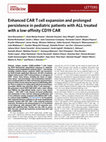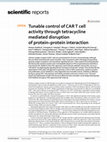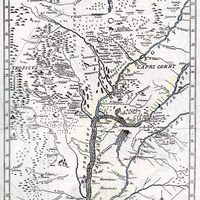Papers by somayya manzoor

Blood, 2019
Background: CD22 is an attractive target for Chimeric Antigen Receptor (CAR) since it is expresse... more Background: CD22 is an attractive target for Chimeric Antigen Receptor (CAR) since it is expressed by most B-cell malignancies. However, CAR targeting of CD22 is challenging since CD22 has a long ectodomain of 300 Å, which is several times wider than the optimal immune synapse. Further, the ectodomain is rigid, so even targeting of membrane proximal domains may not allow effective synapse formation. Further still, CD22 is expressed at low density and dropping of antigen density has been described as a mode of escape. A previously described CD22 CAR based on the M971 antibody required a very short linker between single-chain VH-VL for sensitive function, presumably to allow CAR concatenation but which comes at the cost of basal signalling. Our aim was to engineer an anti-CD22 CAR which triggered not only killing, but proliferation in response to less than 1000 CD22 molecules per cell, without basal signalling. We conducted a functional screen for stable / high affinity binders recogn...

Blood
Background: Anti-CD19 CAR treatment has shown a remarkable response in r/r B-ALL patients, howeve... more Background: Anti-CD19 CAR treatment has shown a remarkable response in r/r B-ALL patients, however, a major cause for relapse following CAR administration is the loss of the CD19 antigen. CD22 is a promising alternative target for B-ALL malignancies, although generating an effective CAR to CD22 is challenging due to the size, density and rigidity of this ligand. Furthermore, in the B-ALL setting the CD22 expression levels are known to down regulate in response to selective CAR pressure. This resulted in patients relapsing with lower CD22 density post-treatment (2,839 epitopes/cell) presumably due to the target density falling below the sensitivity threshold for the aCD22 CAR 1. In this study we aim to improve CAR efficacy for the treatment of r/r B-ALL by firstly developing a highly sensitive aCD22 CAR capable of targeting cells that express less than 1000 CD22 molecules per cell. Secondly, we combined this new aCD22 CAR with an aCD19 CAR to generate a dual targeting CD19 and CD22 p...

Introduction Mature T cell lymphomas are aggressive, treatment resistant cancers that are associa... more Introduction Mature T cell lymphomas are aggressive, treatment resistant cancers that are associated with poor prognosis. Clinical application of immunotherapeutic approaches has been limited by a lack of target antigens that discriminate malignant from healthy T cells. Unlike B cell depletion, pan-T cell aplasia is prohibitively toxic. Previously we reported a targeting strategy based on the mutually exclusive expression of T cell receptor beta-chain constant domains 1 and 2 (TRBC1 and TRBC2). We identified an antibody with unique TRBC1 specificity and demonstrated that anti TRBC1 chimeric antigen receptor (CAR) T cells can ablate cells expressing TRBC1 TCRs while sparing those expressing TRBC2 TCRs. A phase I clinical study investigating the efficacy of our TRBC1 CAR is ongoing. T cell malignancies are clonal, and the ratio of TRBC2 to TRBC1 expressing lymphoma cases is predicted to be approximately 2:1. To treat all cases of T cell lymphoma, a CAR that targets TRBC2 is needed. TR...

Nature Medicine
Chimeric antigen receptor (CAR)-modified T cells targeting CD19 demonstrate unparalleled response... more Chimeric antigen receptor (CAR)-modified T cells targeting CD19 demonstrate unparalleled responses in relapsed/ refractory acute lymphoblastic leukemia (ALL) 1-5 , but toxicity, including cytokine-release syndrome (CRS) and neurotoxicity, limits broader application. Moreover, 40-60% of patients relapse owing to poor CAR T cell persistence or emergence of CD19 − clones. Some factors, including the choice of singlechain spacer 6 and extracellular 7 and costimulatory domains 8 , have a profound effect on CAR T cell function and persistence. However, little is known about the impact of CAR binding affinity. There is evidence of a ceiling above which increased immunoreceptor affinity may adversely affect T cell responses 9-11. We generated a novel CD19 CAR (CAT) with a lower affinity than FMC63, the high-affinity binder used in many clinical studies 1-4. CAT CAR T cells showed increased proliferation and cytotoxicity in vitro and had enhanced proliferative and in vivo antitumor activity compared with FMC63 CAR T cells. In a clinical study (CARPALL, NCT02443831), 12/14 patients with relapsed/refractory pediatric B cell acute lymphoblastic leukemia treated with CAT CAR T cells achieved molecular remission. Persistence was demonstrated in 11 of 14 patients at last follow-up, with enhanced CAR T cell expansion compared with published data. Toxicity was low, with no severe CRS. One-year overall and event-free survival were 63% and 46%, respectively. We have developed a new CD19 single-chain variable fragment (scFV) called CAT, which has shown substantially (>40-fold) lower affinity to CD19 than existing scFvs derived from FMC63 (ref. 12,13) (Extended Data Fig. 1). The higher equilibrium dissociation constant (K D) of CAT (14 nM) was the result of a much faster offrate, which measures how quickly an antibody dissociates from its antigen, for CAT (CAT, 3.1 × 10 −3 s −1 ; FMC, 6.8 × 10 −5 s −1). The on-rate, which characterizes how fast an antibody binds to its target, was equivalent between the two (CAT, 2.2 × 10 5 M −1 s −1 ; FMC, 2.1 × 10 5 M −1 s −1). Key CD19 residues required for CAT and FMC63 binding were identified by sequential mutation analysis. Both antibodies shared important residues within loops 1 (AA 97-107) and 2 (AA 155-166), suggesting that FMC63 and CAT bind to the same or overlapping epitopes on CD19 (Extended Data Fig. 2a,b). The thermal stability and cell-surface stability of CAT and FMC63 singlechain variable fragments linked to single-chain constant fragments (scFv-Fcs) were similar (Extended Data Fig. 2c,d). We compared the function of T cells that were lentivirally transduced with either FMC63 or CAT in identical second-generation CAR formats. These cells had a CD8-derived stalk/transmembrane region, a 4-1BB co-stimulatory domain and a CD3ζ chain, and they co-expressed mCherry fluorescent protein to control for transduction efficiency (Supplementary Fig. 1a-c). The cytotoxicity of CAT CAR T cells against a CD19-expressing cell line (SupT1CD19) was significantly greater than that of FMC63 CAR T cells (Fig. 1a). CAT CAR and FMC63 CAR T cells showed equivalent cytotoxicity against low-density CD19-expressing targets (Supplementary Fig. 2a-c). CAT CAR T cells showed significantly greater antigenspecific proliferation than T cells transduced with the FMC63 CAR (Fig. 1b). Cytokine production by CAT and FMC CAR T cells in response to stimulation with CD19 + targets was similar, except that CAT CAR T cells secreted significantly more tumor necrosis factor-α (TNF-α) than FMC63 CAR T cells (Fig. 1c).

Scientific Reports
Chimeric antigen receptor (CAR) T cells are a promising form of cancer immunotherapy, although th... more Chimeric antigen receptor (CAR) T cells are a promising form of cancer immunotherapy, although they are often associated with severe toxicities. Here, we present a split-CAR design incorporating separate antigen recognition and intracellular signaling domains. These exploit the binding between the tetracycline repressor protein and a small peptide sequence (TIP) to spontaneously assemble as a functional CAR. Addition of the FDA-approved, small molecule antibiotic minocycline, acts as an “off-switch” by displacing the signaling domain and down-tuning CAR T activity. Here we describe the optimization of this split-CAR approach to generate a CAR in which cytotoxicity, cytokine secretion and proliferation can be inhibited in a dose-dependent and reversible manner. Inhibition is effective during on-going CAR T cell activation and inhibits activation and tumor control in vivo. This work shows how optimization of split-CAR structure affects function and adds a novel design allowing easy CA...









Uploads
Papers by somayya manzoor